The Latest News from PA Chapter of APA…
Over 300 planners celebrated National Community Planning Month this October at the Chapter conference in Scranton, which was a great hit. In the newsletter this month, we provide one planner’s review of the chapter conference, highlight the award winners who were honored at the Chapter Conference, and provide background information on how you can acknowledge community planning month in your own area. Enjoy!
 Ethics Cases of the Year
Ethics Cases of the Year
November 1 from 12:00 PM – 1:00 PM
The AICP Code of Ethics was recently revised in 2021 with the updated code going into effect January 1, 2022. This session will present a summary of the updated AICP Code of Ethics followed by a review of several ethical scenarios/case studies. The review of the updated AICP Code of Ethics will include a refresher on aspirational principles, rules of practice and behavior, and procedures for enforcement of the code. Key components of the AICP Code of Ethics that changed will be highlighted. The ethical scenarios/case studies will feature perspectives applicable to both public and private sector planners. The ethical scenarios/case studies are based on real-life planning issues from past years developed by the AICP Ethics Committee, with the assistance of AICP Ethics Officer Ralph Willmer, FAICP. Active participation and interaction between the presenters and participants will be encouraged. Attendees will have the opportunity to express their opinions on the ethical scenarios/case studies. (PLEASE NOTE: This is the same session from the APA PA Annual Conference if you attended.)
Deadline to register is October 31.
Ethics CM credit is pending approval. You must attend the webinar live to earn CM credit.
**The Pennsylvania Chapter is not responsible for the materials or opinions of the speaker(s) you will hear**
Earn over 50 CM credits each year online – at no cost to members of participating organizations that support the Planning Webcast Series. Webcasts take place live on Fridays from 1:00 – 2:30 PM ET and are worth 1.5 CM credits (for live viewing only) unless otherwise noted. More information online.
For APA members that need CM credit for on-demand education sessions are available. The Planning Webcast Series, sponsored by APA Chapters & Divisions, are offering credit till the end of the year (12/31/2023). More information online.
Communication and Membership Committee
The Communication and Membership Committee is working with Bull Moose Marketing to complete a Communication Plan for the Chapter. Please take a moment to complete the online survey.
The Communication and Membership Committee is looking for volunteers to contribute articles for our monthly E-News. If you are interested or would like more information, please contact Amy Evans or Amy McKinney.
Each year the Chapter offers a scholarship to support individuals seeking funds for academic degree programs, internships, and professional development activities. If anyone would like to contribute to the Chapter’s Scholarship fund, donations can be made here. We accept all major credit cards, or you can send a check. Please make your check payable to “PA Chapter of APA Scholarship Fund” and mail it to P.O. Box 4680, Harrisburg PA 17111.
FEMA Region 3 Coffee Breaks Webinar Series
FEMA Region 3 hosts a webinar series for anyone who wants to reduce risk in their community. These hour-long “Coffee Breaks” are held every other month. FEMA staff share mitigation best practices and highlight the work happening at the federal, regional, state and community levels to reduce risk in Region 3. Coffee Break webinars are open to anyone in the hazard mitigation, resiliency, or risk reduction planning fields. This work can be in the public or private sectors. Community planners, emergency and floodplain managers, GIS technicians, government officials, and contractors – or anyone interested – is welcome to attend. You can find more information here.
- Conducting a Risk Assessment
November 8, 2023 from 11:00 AM – 12:00 PM Eastern Time
When creating a hazard mitigation plan, the risk assessment details the hazards that your community faces. Documenting the geographies, populations, and critical facilities at risk will help you identify ways to promote resilience. This webinar will guide you through the risk assessment process.
Laughing and Learning at the 2023 APA PA Conference in Scranton
By Amy Evans, AICP
 If you ask planners why they attend the APA PA Annual Conference, you’ll usually hear something about catching up with best practices and colleagues across the state or getting CM credits, those pesky things that AICP-certified planners need 32 of every two years. But really, there’s so much more to it than that!
If you ask planners why they attend the APA PA Annual Conference, you’ll usually hear something about catching up with best practices and colleagues across the state or getting CM credits, those pesky things that AICP-certified planners need 32 of every two years. But really, there’s so much more to it than that!
Here’s what the 2023 Conference was like for one planner in particular …
My husband and I work in very different fields but are both certified planners, so it’s great to be able to do a conference together. Neither of us had been to Scranton before and we were curious about its history and design. The conference hotel is in the historic downtown, so it was an easy walk to most of the “must-see” sights. Now if only the weather had cooperated! Fortunately, Maria MacDonald at Marywood University was our Monday morning keynote speaker, who shared Scranton’s many connections to Jane Jacobs and how her observations and principles have been put into practice locally.
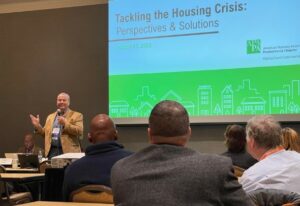 A lot of my day-to-day work lies in helping people impacted by current housing market pressures, so I looked for sessions on solutions built and tested here in Pennsylvania. Across the four I attended that focused on housing, I picked up insights about why the market is the way that it is and why there aren’t any easy answers. I was particularly impressed by a collaboration between the City of Bethlehem, a local nonprofit, and Michael Baker International to locate and fund a permanent year-round shelter for the Lehigh Valley.
A lot of my day-to-day work lies in helping people impacted by current housing market pressures, so I looked for sessions on solutions built and tested here in Pennsylvania. Across the four I attended that focused on housing, I picked up insights about why the market is the way that it is and why there aren’t any easy answers. I was particularly impressed by a collaboration between the City of Bethlehem, a local nonprofit, and Michael Baker International to locate and fund a permanent year-round shelter for the Lehigh Valley.
Sunday evening means one thing at the conference: It’s time for the Welcome Reception! The reception venues are always intriguing. This time it was the Scranton Cultural Center, a former Masonic Temple with gorgeous Neo-gothic architectural details throughout. This was a great time to catch up with friends and colleagues we hadn’t seen since last years’ conference. We even got to hang out with the municipal manager of our home borough, Columbia.
I am the Chair of APA PA’s Communication & Membership Committee, and our group is currently developing a Communications Plan for the Chapter. At last year’s conference, I attended a session by Steve Thomas in Franklin County, Tim Staub at HRG, and Todd Poole of 4ward Planning about how to manage an RFP process. I put that knowledge to use right away in writing an RFP for communications planning services for the Chapter. We eventually selected Bull Moose Marketing in Meadville PA to do the work. With the plan well underway, of course we were going to take advantage of having so many planners under one roof. Ron Mattocks from Bull Moose joined us in Scranton; hopefully you were able to talk to him! He and I also got to share our work with you during Monday’s lunchtime Chapter Address.
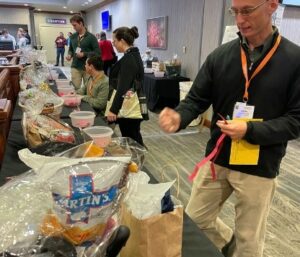 Another conference tradition is the basket raffle on the last day. Each year, our members and their organizations donate fabulous gift baskets, with ticket sales supporting the Chapter’s Scholarship Fund. The competition is fierce. Imagine my surprise at winning the basket donated by the York County Planning Commission, where I worked for the majority of my career. YCPC, you really know how to put a basket together!
Another conference tradition is the basket raffle on the last day. Each year, our members and their organizations donate fabulous gift baskets, with ticket sales supporting the Chapter’s Scholarship Fund. The competition is fierce. Imagine my surprise at winning the basket donated by the York County Planning Commission, where I worked for the majority of my career. YCPC, you really know how to put a basket together!
After the raffle, there was one final set of sessions. I learned so much from Zach Norwood in Crawford County and Todd Poole of 4ward Planning as they shared their joint work to produce a Housing Plan responsive to varying needs throughout the county. I plan to use several of their approaches in tackling changes to how and where human services are provided here in York County.
 What I’ve shared so far is really just a highlight reel. I haven’t even touched on the resources and fun take-aways in the Exhibit Hall, the events and sessions for students and emerging professionals, the excellent plenary speakers, the mobile workshops that get planners out into the field, the Monday night social, or the countless connections I made to fellow planners who are dealing with the same issues and challenges I am. Many thanks to Kim Gusic, our Chapter Administrator, and her team, as well as the Conference Planning Committee and the Northeast Section for putting together another enriching experience.
What I’ve shared so far is really just a highlight reel. I haven’t even touched on the resources and fun take-aways in the Exhibit Hall, the events and sessions for students and emerging professionals, the excellent plenary speakers, the mobile workshops that get planners out into the field, the Monday night social, or the countless connections I made to fellow planners who are dealing with the same issues and challenges I am. Many thanks to Kim Gusic, our Chapter Administrator, and her team, as well as the Conference Planning Committee and the Northeast Section for putting together another enriching experience.
Next year APA PA will be in Erie; we hope to see you there!
2023 Pennsylvania Chapter Planning Awards
By Craig Peiffer, AICP and Brian O’Leary, AICP
The Awards Luncheon at the 2023 Chapter Conference in Scranton honored the best and brightest that planning has to offer in Pennsylvania. This year’s awards featured an excellent neighborhood plan, a very useful and usable online toolkit, a long-running and successful open space program, and an impactful citizen planner. Press release is available online.
- Award for a Plan: West Ward Choice Neighborhood Plan
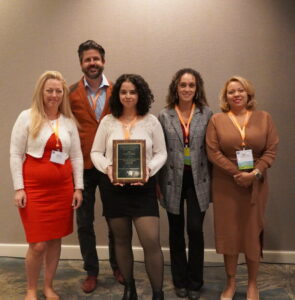 The Choice Neighborhoods Initiative is a Department of Housing and Urban Development (HUD) program that employs a comprehensive approach to neighborhood transformation by revitalizing distressed public and/or assisted housing and catalyzing critical improvements in the neighborhood. In 2020, the Easton Housing Authority, in partnership with the Greater Easton Development Partnership and the City of Easton were awarded a Choice Neighborhoods Planning Grant.
The Choice Neighborhoods Initiative is a Department of Housing and Urban Development (HUD) program that employs a comprehensive approach to neighborhood transformation by revitalizing distressed public and/or assisted housing and catalyzing critical improvements in the neighborhood. In 2020, the Easton Housing Authority, in partnership with the Greater Easton Development Partnership and the City of Easton were awarded a Choice Neighborhoods Planning Grant.
With this grant, the Authority created the West Ward Choice Neighborhood Plan, which built upon a 2019 Neighborhood Plan, targeting three core areas for redevelopment and updating and adapting previous planning efforts to focus on the core goals of People, Housing and Neighborhood.
The plan’s strategy of community engagement was to employ three Housing Authority residents to serve as community ambassadors. Trained and coached on engagement techniques, the ambassadors have become “champions” for the plan. Residents were further involved in working group meetings, community meetings, youth engagement and needs assessment surveys. The resulting plan goes beyond bricks and mortar to address broader issues such as education, health, safety, economic development, and other supportive services.
Part of the process is to have early successes that demonstrate that the plan can make a difference. During the planning process, $150,000 was allocated for community-defined early action projects. These included little free libraries, a community garden, and a neighborhood gateway signage initiative. The plan also led to the successful award of a $1.1 million state grant to fund a community bike works club and “safe routes to school” program!
Perhaps most impactful thus far, the plan has led to the strategic acquisition of two properties. The first site, adjacent to an existing apartment development, will permit new construction to expand the number of affordable and mixed-income housing units. The second site is a former large nursing home. This site will allow for the partnership to move forward with a build-first strategy for 50 units, before demolishing any existing Housing Authority units.
HUD acknowledged the efforts of the team to refine a considerable amount of work and include possible financing plans, a mix of incomes, a mix of uses and recreational amenities in several compelling design solutions. The Chapter’s Award Committee concurred with HUD’s assessment, noting that the plan was graphically imaginative, reflected an emphasis on community design, and included practical solutions with a list of actions, partners, timeframe, and probable costs.
- Award for a Project, Program or Practice: The Tri-County Regional Planning Commission Planning Toolkit
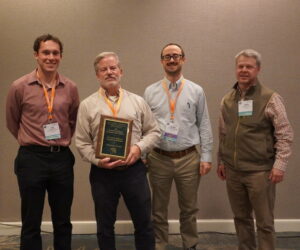 In 2021, the Tri-County Commission sought to improve upon its existing online toolkit to provide clear, concise, and current information on planning topics to planners, solicitors, elected or appointed officials, and the public. Located in South Central Pennsylvania, with a wide variety of urban, suburban and rural areas, the Commission found that there wasn’t a place providing a one stop shop for quick references, technical guides, and model ordinances; so, they determined that better resources were needed.
In 2021, the Tri-County Commission sought to improve upon its existing online toolkit to provide clear, concise, and current information on planning topics to planners, solicitors, elected or appointed officials, and the public. Located in South Central Pennsylvania, with a wide variety of urban, suburban and rural areas, the Commission found that there wasn’t a place providing a one stop shop for quick references, technical guides, and model ordinances; so, they determined that better resources were needed.
The Commission began by tracking existing “hits” on their existing toolkit website, then surveying over 70 municipalities and hosting two conference sessions to solicit planner’s input at the 2020 and 2021 APA PA Conferences. This resulted in identification and prioritization of approximately 40 planning topics, from traditional topics to current trends, including short-term rentals, accessory dwelling units, tiny houses, food trucks, drones, and e-scooters and e-bikes.
The Planning Toolkit includes two-page fact sheets for each topic, providing easy-to-understand background information, pros and cons, and resources and examples, most of which include hyperlinks for a more in-depth dive. The commission also integrated an, “interested in a topic not included here” feature to track emerging trends and to manage overall content.
The toolkit was launched in 2022, and to date has received over 2,000 hits. This interest has translated into a number of municipalities seeking assistance from the Commission to update their zoning, subdivision and land development, and other ordinances. The site has also become a resource for professors and students studying and modeling planning principles, as well as planners statewide, who use the content as part of their community outreach. The Chapter Awards Committee noted that the toolkit provides “great access to planning that addresses current planning issues, is accessible, includes success stories, and is highly transferrable.”
- Award for a Project, Program or Practice: Chester County Open Space Protection Planning Program
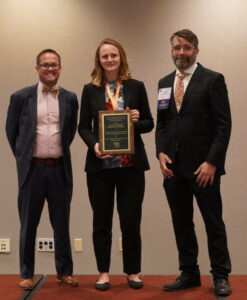 Prompted by a rapid loss of farmland and open space, Chester County’s Open Space Protection Programs began in the late 1980s, with the State’s first referendum to preserve open space. Since then, policies and practices aligned with public support and continuous funding has positioned Chester County as a statewide leader in land preservation and smart growth. Landscapes 3, established in 2018, is the updated comprehensive plan and seeks to advance the protection and stewardship of open space, farmland, and natural and cultural features to realize economic, ecological, and quality of life benefits.
Prompted by a rapid loss of farmland and open space, Chester County’s Open Space Protection Programs began in the late 1980s, with the State’s first referendum to preserve open space. Since then, policies and practices aligned with public support and continuous funding has positioned Chester County as a statewide leader in land preservation and smart growth. Landscapes 3, established in 2018, is the updated comprehensive plan and seeks to advance the protection and stewardship of open space, farmland, and natural and cultural features to realize economic, ecological, and quality of life benefits.
Early on in the implementation process, the county sought to reframe the narrative and provide a quantitative understanding of the economic value of open space by publishing, Return on Environment, in 2019. Recognizing the value of carbon sequestration and storage, and to reduce the county’s carbon footprint, the county adopted Climate Action Plan in 2021. To support municipalities, preservation organizations, government agencies and landowners, the county developed an interactive open space tools map which explores where open space is being planned and where best to focus efforts. The map is coupled with a toolkit to provide guidance on agricultural zoning, conservation subdivision regulations, and transfer of development rights.
Recognizing that 12% of the county’s open space is protected by HOAs, the county updated its Conservation Subdivision Design Guide in 2022, with a principal goal of encouraging development proposals with high recreational, scenic, and ecological value.
Begun as the Vision Partnership Program in the 1990s, and in high demand today, the county provides funding for open space plans and ordinances, provided that they implement the policies of Landscapes 3.
In 2019, Chester County celebrated the 30th Anniversary of its Open Space Program. In 2021, the county reached the milestone of 30% protected open space, or the preservation of 148,000 acres and counting! In 2023, 78% of municipalities have adopted open space plans! The Chapter Awards Committee highlighted an excellent website, materials, and community engagement, and noted that perhaps as equally compelling is the spectacular demonstration of support, as evidenced in support letters from partner organizations.
- Award for a Leader – Citizen Planner: Dulcie Flaharty, Vice Chair, Montgomery County Planning Commission
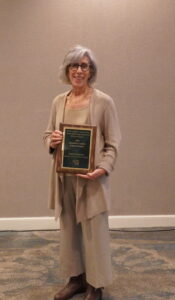 Common among many Citizen Planners, Dulcie’s path to the planning profession came through her interest in open space preservation. A passionate conservationist, Dulcie was instrumental in the founding of the 1993 Montgomery County Land Trust, later to be merged with Natural Lands. In this role, she has been responsible for creating conservation easements on over 47 properties, permanent protection of nearly 3,000 acres of land, and educational outreach to over 1,800 municipal leaders. Equally significant has been her advocacy to pass Montgomery County’s first Open Space Program; leading voter turnout to pass, in every municipality, a referendum to have the County Commissioners spend money on open space and a ballot initiative to earmark $150 million toward the effort!
Common among many Citizen Planners, Dulcie’s path to the planning profession came through her interest in open space preservation. A passionate conservationist, Dulcie was instrumental in the founding of the 1993 Montgomery County Land Trust, later to be merged with Natural Lands. In this role, she has been responsible for creating conservation easements on over 47 properties, permanent protection of nearly 3,000 acres of land, and educational outreach to over 1,800 municipal leaders. Equally significant has been her advocacy to pass Montgomery County’s first Open Space Program; leading voter turnout to pass, in every municipality, a referendum to have the County Commissioners spend money on open space and a ballot initiative to earmark $150 million toward the effort!
Beyond conservation, Dulcie’s foray into planning began with serving as a Member of the Board of the Montgomery County Planning Commission, where she currently serves as Vice-Chair. Dulcie also served as a Member of the Steering Committee for Montco 2040, the county’s current comprehensive plan. Dulcie has served the planning community regionally as a Member of the Board of Directors for the Valley Forge Tourism and Convention Board and statewide as a Member of the Board and Policy Committee of the Pennsylvania Land Trust Association.
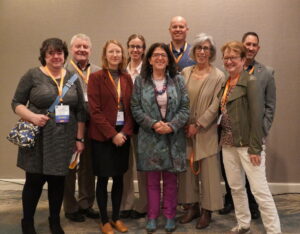 Summarizing accolades from her peers, Dulcie’s 30 plus years of service to planning can best be described with her more recent successes. These include participating in the publication of Return on Environment: the Economic Impact of Protected Open Space in Montgomery County and lobbying for changes to a Pennsylvania Law that had enabled eminent domain of land thought to be permanently preserved, thereby saving Stoneleigh, a 42-acre natural garden property in Villanova. The Chapter Awards Committee recognized that her educational outreach work plus land conservation has had a significant impact to the county. She clearly has the support of the Montgomery County Planning Staff, is viewed as a partner by elected and appointed officials, and is an advocate for the greater public good. In other words, she is a difference maker!
Summarizing accolades from her peers, Dulcie’s 30 plus years of service to planning can best be described with her more recent successes. These include participating in the publication of Return on Environment: the Economic Impact of Protected Open Space in Montgomery County and lobbying for changes to a Pennsylvania Law that had enabled eminent domain of land thought to be permanently preserved, thereby saving Stoneleigh, a 42-acre natural garden property in Villanova. The Chapter Awards Committee recognized that her educational outreach work plus land conservation has had a significant impact to the county. She clearly has the support of the Montgomery County Planning Staff, is viewed as a partner by elected and appointed officials, and is an advocate for the greater public good. In other words, she is a difference maker!
Celebrate National Community Planning Month!
By Betsy Logan, AICP
Did you know October is National Planning Month? Sponsored by the American Planning Association (APA), this annual observance is an opportunity to recognize the critical role that planning plays in shaping the future of our communities. The APA believes quality planning leads to better communities that are more equitable, resilient, and economically prosperous. This year’s theme, “Building Communities for All,” emphasizes the importance of inclusivity and diversity in planning efforts. It encourages planners and communities to think about how to create places that are welcoming, accessible, and beneficial for all residents, regardless of age, background, or ability.
How can you participate in National Planning Month? There are numerous ways to get involved in National Planning Month, including:
- Download the National Community Planning Month graphics to use in your materials.
- Encourage elected officials to proclaim October as Community Planning Month. A template proclamation is available on the website.
- Get inspiration through training, conferences, and other resources
- Share your ideas and thoughts on planning issues using #communityplanning
- Participate in local events and discussions
By celebrating National Planning Month, we can highlight the significant role community planning plays in creating places for everyone.

